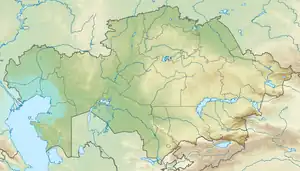| Terisaqqan Терісаққан / Терсаккан | |
|---|---|
 Mouth location in Kazakhstan | |
| Location | |
| Country | Kazakhstan |
| Physical characteristics | |
| Source | |
| • location | Ulutau Kazakh Uplands |
| Mouth | Ishim |
• coordinates | 51°14′58″N 67°09′33″E / 51.2494°N 67.1592°E |
| Length | 334 km (208 mi) |
| Basin size | 19,500 km2 (7,500 sq mi) |
| Discharge | |
| • average | 52.7 cubic metres per second (1,860 cu ft/s) |
| Basin features | |
| Progression | Ishim→ Irtysh→ Ob→ Kara Sea |
The Terisaqqan (Kazakh: Терісаққан, Terısaqqan; Russian: Терсаккан, Tersakkan) is a river of northern Kazakhstan. A left tributary of the Ishim, it is 334 kilometres (208 mi) long and has a basin area of 19,500 square kilometres (7,500 sq mi).[1] It flows through the western parts of the Kazakh Uplands and the average annual flow is approximately 2.5 cubic metres per second (88 cu ft/s), with a maximum up to 52.7 cubic metres per second (1,860 cu ft/s). In the upper reaches it dries up, and it freezes to the bottom in some winters.[1] Peak flow is in April during snowmelt.
References
This article is issued from Wikipedia. The text is licensed under Creative Commons - Attribution - Sharealike. Additional terms may apply for the media files.